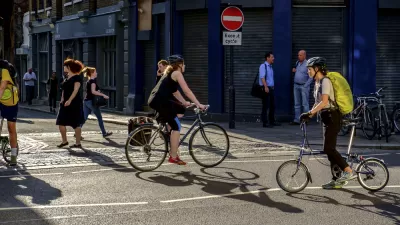According to Chris Peck, “Better cycling infrastructure, an enforced road traffic law and a reduction in the space available to motor traffic are all required to get cycling growing again in London.”
"The mayor of London's 'cycling Revolution', launched in 2010, was revolutionary in name only,” writes Chris Peck, policy coordinator of the UK's national cyclists' organization, the Cyclists' Touring Club (CTC). A bit of a mixed bag, London's citywide cycling campaign has seen its share of successes and failures. Accomplishments include the implementation of a bicycle borrowing system, the creation of cycling superhighways, and ushering in a 10-15% increase in cycling levels. But, all this development has been costly for London at about £10 per head, and several high-profile deaths and what many feel is poorly design cycling infrastructure and regulation have been accompanied by a recent decline in cycling levels.
Since 2007, “both nationally and in London, cycle casualties have been increasing faster than the rate of cycling, undermining the idea that if you get more people cycling, it will inevitably become safer,” writes Peck. In fact, he asserts that in London, unlike in cities such as Copenhagen and Amsterdam, the “safety in numbers” idea has failed to materialize. This is due to a variety of factors related to both infrastructure and policing, as well as road user behavior. "The problem with so much existing cycle infrastructure is that it does little to improve safety, but also undermines the status of cycling, relegating them to a narrow, unhelpful cycle lane the users of which must give way to all other road users," writes Peck.
FULL STORY: Why is there no safety in numbers for London's cyclists?

Pennsylvania Mall Conversion Bill Passes House
If passed, the bill would promote the adaptive reuse of defunct commercial buildings.

Planning for Accessibility: Proximity is More Important than Mobility
Accessibility-based planning minimizes the distance that people must travel to reach desired services and activities. Measured this way, increased density can provide more total benefits than increased speeds.

World's Largest Wildlife Overpass In the Works in Los Angeles County
Caltrans will soon close half of the 101 Freeway in order to continue construction of the Wallis Annenberg Wildlife Crossing near Agoura Hills in Los Angeles County.

New York Passes Housing Package Focused on New Development and Adaptive Reuse
The FY 2025 budget includes a new tax incentive, funding for affordable housing on state land, and support for adaptive reuse and ADUs.

LA Metro Board Approves New 710 Freeway Plan
The newest plan for the 710 corridor claims it will not displace any residents.

Austin’s Proposed EV Charging Rules Regulate Station Locations, Size
City planners say the new rules would ensure an efficient distribution of charging infrastructure across the city and prevent an overconcentration in residential areas.
City of Costa Mesa
Licking County
Barrett Planning Group LLC
HUD's Office of Policy Development and Research
Mpact Transit + Community
HUD's Office of Policy Development and Research
Tufts University, Department of Urban and Environmental Policy & Planning
City of Universal City TX
ULI Northwest Arkansas
Urban Design for Planners 1: Software Tools
This six-course series explores essential urban design concepts using open source software and equips planners with the tools they need to participate fully in the urban design process.
Planning for Universal Design
Learn the tools for implementing Universal Design in planning regulations.


























